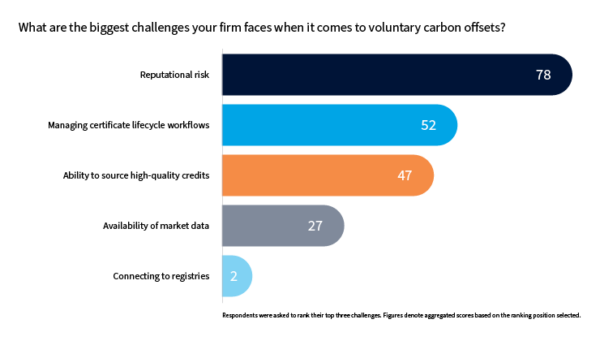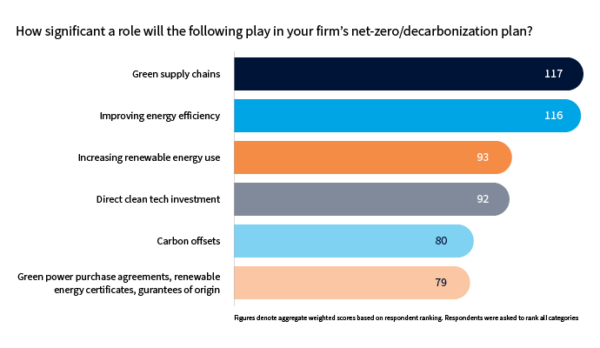Navigating the road to net zero: Carbon offsets as a key strategy
Introduction
As corporate net zero pledges surge, many companies are actively strategizing to achieve decarbonization goals. The task is easier said than done, and achieving net zero status can be both difficult and costly. Carbon markets, which offer a potentially cost-effective way of becoming net-zero quickly, are expected to play a huge role in this effort.
However, a recent survey conducted by Risk.net in association with ION Commodities revealed that firms are taking a cautious approach to using carbon offsets in their net-zero plans. Respondents ranked carbon offsets fifth out of six strategies for achieving their decarbonization goals. Greening supply chains emerged as the preferred method, followed by improving energy efficiency and increasing renewable energy use.
 Image source: risk.net survey
Image source: risk.net surveyOvercoming controversies and unlocking opportunities in VCMs
Overcoming controversies
The cautious stance on carbon offsets reflects concerns about operational and reputational risks associated with Voluntary Carbon Markets (VCMs). Controversies around carbon offset strategies, fueled by recent investigations into dubious emission reduction claims, have led to skepticism. Despite these recent setbacks and concerns, market experts still believe carbon offsets present a viable solution for organizations aiming for an ambitious net-zero timeline and emphasize the need for credible offset solutions.
VCM market growth potential
Businesses need to navigate these controversies to leverage the benefits of carbon offsets. Currently covering only 0.2% of global emissions, the majority of VCM projects are avoidance schemes, such as REDD+ forestry projects. However, this landscape is expected to shift, with estimates suggesting that carbon dioxide removal (CDR) projects will comprise 56% of VCM projects by 2030.
While VCMs offer growth potential, mandatory carbon-trading schemes currently dominate the space, comprising a market worth $900 billion – 450 times the size of VCM – and covering 30% of global emissions. The survey highlights that over 88% of respondents not currently under a compliance scheme anticipate falling under one in the next five to ten years.
Strategic considerations and early involvement
Timing plays a crucial role for firms targeting net zero by 2030. Meeting decarbonization targets, whether through direct engagement with VCMs, compliance schemes, or mechanisms like carbon border taxes, is becoming essential for economic viability as part of firms’ business strategy. Early involvement in VCMs, especially in carbon dioxide removal (CDR) projects, could provide a competitive edge and potential cost advantages.
Best practices in achieving net zero using carbon offsets
Managing risk and assessing project quality
The survey delves into the challenges firms face in adopting voluntary carbon offsets, with reputational risk topping the list. Availability of data and challenges in connecting to registries also pose substantial obstacles. To mitigate reputational risk, firms need optimal methods for assessing project quality and offset credibility. An aggregated approach to offset ratings, combining scores from multiple rating agencies, is suggested to enhance credibility.
 Image source: risk.net survey
Image source: risk.net surveyTracking emissions accurately
Accurate measurement and tracking of emissions form the backbone of any net-zero strategy. However, concerns arise over the accuracy of emissions calculations. Challenges exist in measuring scope 1 (direct) and scope 2 (indirect) emissions, with scope 3 (supply chain) emissions being particularly challenging. The survey indicates that more than 80% of firms have a dedicated resource or a team overseeing decarbonization plans. A dedicated software solution with an optimal process for gathering emissions and certificate data will be a critical part of scaling these efforts.
Navigate the policy and regulatory landscape
While policy and regulations shape carbon markets, clarity is vital. The EU’s directive against greenwashing and restrictions from organizations like the Science Based Targets initiative (SBTi) emphasize the importance of direct action for emissions reduction. Navigating regulatory landscapes is key for organizations incorporating carbon offsets into their net-zero strategies.
Carbon Zero: A strategic ally for achieving net zero
In discussing the findings from the survey and the different ways businesses are approaching their net zero goals, it is important to understand that technology is paramount. This is why ION has developed Carbon Zero, a feature-rich SaaS solution, to align with the evolving dynamics of the carbon markets and help companies navigate the journey of achieving net zero effortlessly.
With Carbon Zero, businesses can trade, hedge, and track carbon credits, manage inventory, streamline compliance workflows, and automate registry operations and reconciliations – all in one place.
By implementing a solution like Carbon Zero, businesses can:
- Manage the full carbon credit lifecycle
- Leverage data on 8000+ global carbon projects
- Mitigate risk in a maturing market
- Meet evolving emissions regulations
- Calculate and forecast carbon-offset obligations
- Simplify reporting and compliance
Conclusion
Achieving net zero presents numerous challenges for firms, including adjusting plans as regulations and technologies evolve. The cost of carbon abatement, as well as the investment required, make moving to net zero a costly endeavor. Firms that want to reach net zero by 2030 will almost certainly need to use carbon offsets due to their ability to be rolled out quickly with minimal disruption to day-to-day business. Early involvement in VCMs coupled with the right technology could provide them with a competitive edge and potential cost advantages.


